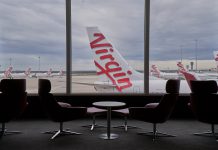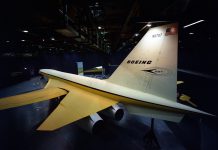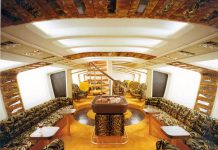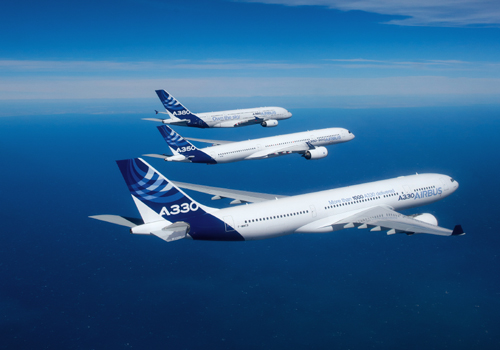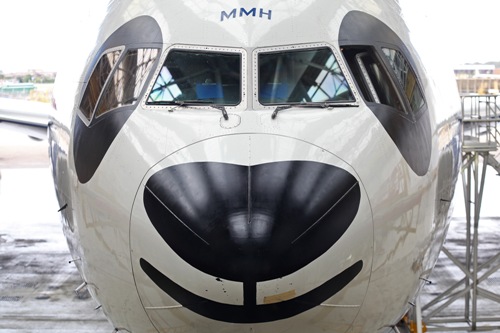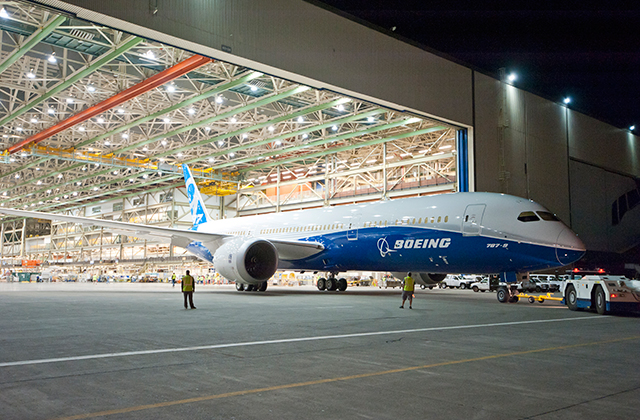The latest version of the Boeing 787, the -9 variant, took to the air on Tuesday at 11.02 am and made a successful trouble free flight from Paine Field in Everett, Washington, adjacent to the company’s 787 / 777 / 767 / 747 assembly buildings.
With its distinctive new Boeing livery, the 787-9 completed a 5 hour, 16 minute flight landing at 4:18pm at Seattle’s Boeing Field.
(See take-off video below)
“Today’s first flight marks a significant milestone for our team, including our partners,” said Boeing Commercial Airplanes President and Chief Executive Officer Ray Conner. “
During the flight, 787-9 Senior Project Pilot Mike Bryan and 787 Chief Pilot Randy Neville departed to the north, reaching an altitude of 20,400 feet (6,218 meters) and an airspeed of 250 knots, or about 288 miles (463 kilometers) per hour, customary for a first flight.
While Captains Bryan and Neville tested the aircraft’s systems and structures, onboard equipment transmitted real-time data to a flight-test team on the ground in Seattle.
Powered by two Rolls-Royce Trent 1000 engines, the first 787-9 will be joined in flight test by two additional aircraft, one of which will feature General Electric GEnx engines. Those aircraft are in the final stages of assembly in Boeing’s Everett factory. Over the coming months, the fleet will be subjected to a variety of tests and conditions to demonstrate the safety and reliability of the aircraft’s design.
The 787-9 can carry an additional 40 passengers for a total of 290 in a mixed class layout.
Boeing’s newest variatnt accounts for 388 of the 936 787s sold.
First flight test aircraft will eventually be delivered to Air New Zealand in mid-2014.
Unlike the 787-8 production the 787-9 build has gone very smoothly and is on track – or at least on the revised production timetable.
Boeing’s Vice President – 787 Derivatives Mark Jenks, who has been with the 787 since its inception and has seen the good the bad and the ugly of the program is very upbeat.
“There is no question that the 787-9 production has benefited from the hard lessons of the 787-8,” said Jenks. “The performance of the 787-9 has just been extremely steady.”
Amazingly, instead of [the 787-9] gaining weight it has lost several hundred pounds compared to its final configuration in 2010.
“So, again, given some of the struggles in the past on this program, it’s been really very encouraging.”
In fact the 787-9 schedule reset two years ago has been maintained. “This is much more in keeping with our tradition of doing airplanes.” And Jenks adds, “there is very little –[almost none] – travelled work.”
While the 787-8 looks nice the 787-9 looks just right.
With a 6.1m stretch the 787-9 can carry 40 more passengers and has a nominal seat count of 290 in three classes. It also has another 555km in range for 15,700km.
Air New Zealand will get the first three examples which are Line numbers 126, 133 and 139.
All Nippon Airways will its first 787-9 after Air New Zealand with Line number 146.
The Qantas Group has 50 options for the 787-9.


